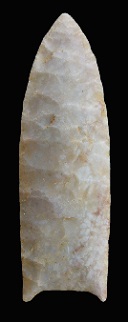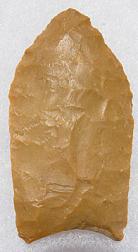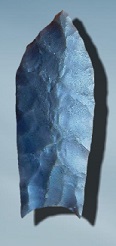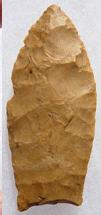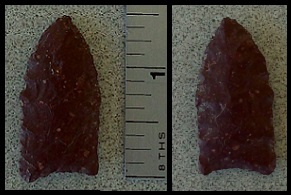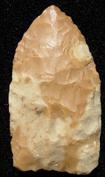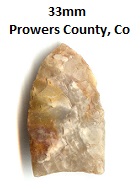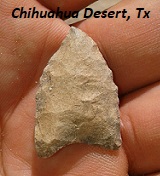Other Websites with Detailed Information:
Name Details:
Named By: Fred Wendorf, Alex Krieger, Claude C. Albritton, and Thomas D. Stewart
Named For: Town near type site
Date Identified: 1955
Type Site: Scharbauer Site, Midland County, Texas
Midland
Cluster: Plano Lanceolate Cluster
Commonly Utilized Material:
High quality materials. Heat treatment is not used
on this type.
Date:
Cultural Period:
10,900 - 10,200 B.P.
Transitional Paleo
Late Pleistocene to Early Holocene
Glacial Period:
Culture:
Outline is Representative of Size and Shape:
Description of Physical Characteristics and Flaking Pattern:
This is a
thin small to medium lanceolate point with a flattened cross section. The blade is excurvate with the widest part of the blade being on the top third.
The blade commonly has fine and regular steep re-touching. The base may vary from concave to straight.
Grinding is present on the lateral hafting region commonly to the
widest part of the blade, but only light or no grinding is
present in the basal concavity. Basal thinning is created by
the removal of three to four short flakes on one face. The flaking pattern
may range from horizontal to parallel oblique or random.
Size Measurements: Length - 30 to 80 mm, Width - 16 to 28 mm,
Thickness - 3 to 5 mm
Distribution:
Distribution Comments:
This point is found in the Plains region from
southern Canada into northern Mexico. This point is similar to the
Folsom point and may have the same distribution.
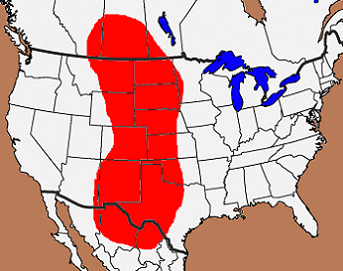
Related / Associated Points:
Additional Comments:
It has been thought that this point represents an
un-fluted Folsom point. However, as Frison (1978) points out, Midland
points are found at sites unassociated with Folsom point. This suggest
that these are not simply un-fluted Folsom points, but represent a
completely different complex. There are two different outlines that
are considered Midland points. The first one is un-fluted, but has a
fluting platform or nipple at the center of the base (may represent a true
un-fluted Folsom point). The second has a concave base and no fluting
platform or remnants of a platform in the center of the base (may represent
a true Midland point). Many people feel that these points are a
transitional point between the older fluted points and the newer points of
this cluster, thought this still remains unresolved. This point is
associated with the Bison hunting tradition.
These points are similar to the longer, thicker Milnesand points.
Goshen points have similar characteristics and may represent the same type
(Morrow, 2016).
Point Validity: Valid Type
Wendorf was a distinguished anthropologist and professor emeritus for the Department of Anthropology at the Southern Methodist University. Krieger was a renowned anthropologist who spent most of his career in Texas cataloging projectile points and pottery in Texas before moving on to the University of Washington.
Albritton was a professor of Geology at the Southern Methodist University. Stewart is the founder of forensic anthropology. This type was named in a professional publication and has many professional
references. This is considered a valid type.
.
Age Details:
Goshen Complex
References: (See Reference Page, Entry Number):
23, 30, 39, 169, 176, 180, 215, W2
Midland Projectile Point, Midland Arrowhead

